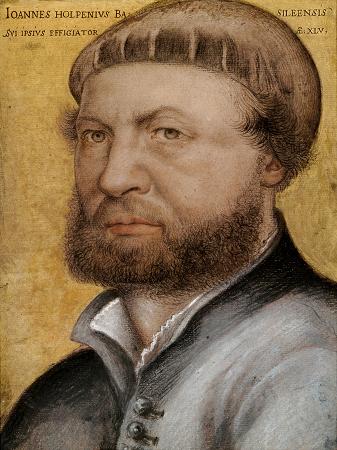Hans Holbein the Younger (c1497 - 1543). Hans Holbein the Younger was a German painter and printmaker who worked in a Northern Renaissance style, and is considered one of the greatest portraitists of the 16th century. He also produced religious art, satire, and Reformation propaganda, and he made a significant contribution to the history of book design. He is called the Younger to distinguish him from his father Hans Holbein the Elder, an accomplished painter of the Late Gothic school. Holbein was born in Augsburg, but he worked mainly in Basel as a young artist. At first, he painted murals and religious works, designed stained glass windows, and printed books. He also painted an occasional portrait, making his international mark with portraits of humanist Desiderius Erasmus of Rotterdam. When the Reformation reached Basel, Holbein worked for reformist clients while continuing to serve traditional religious patrons. His Late Gothic style was enriched by artistic trends in Italy, France, and the Netherlands, as well as by Renaissance humanism. The result was a combined aesthetic uniquely his own. Holbein travelled to England in 1526 in search of work, with a recommendation from Erasmus. He was welcomed into the humanist circle of Thomas More, where he quickly built a high reputation. He returned to Basel for four years, then resumed his career in England in 1532 under the patronage of Anne Boleyn and Thomas Cromwell. By 1535, he was King's Painter to Henry VIII of England. In this role, he produced portraits and festive decorations, as well as designs for jewellery, plate, and other precious objects. His portraits of the royal family and nobles are a record of the court in the years when Henry was asserting his supremacy over the Church of England. Holbein's art was prized from early in his career. French poet and reformer Nicholas Bourbon dubbed him the Apelles of our time, a typical accolade at the time. Holbein has also been described as a great one-off of art history, since he founded no school. Some of his work was lost after his death, but much was collected, and he was recognised among the great portrait masters by the 19th century. Recent exhibitions have also highlighted his versatility. He created designs ranging from intricate jewellery to monumental frescoes. Holbein's art has sometimes been called realist, since he drew and painted with a rare precision. His portraits were renowned in their time for their likeness, and it is through his eyes that many famous figures of his day are pictured today, such as Erasmus and More. He was never content with outward appearance, however; he embedded layers of symbolism, allusion, and paradox in his art, to the lasting fascination of scholars. In the view of art historian Ellis Waterhouse, his portraiture remains unsurpassed for sureness and economy of statement, penetration into character, and a combined richness and purity of style. Holbein was born in the free imperial city of Augsburg during the winter of 1497-98. He was a son of the painter and draughtsman Hans Holbein the Elder, whose trade he and his older brother, Ambrosius, followed. Holbein the Elder ran a large and busy workshop in Augsburg, sometimes assisted by his brother Sigmund, also a painter. By 1515, Hans and Ambrosius had moved as journeymen painters to the city of Basel, a centre of learning and the printing trade. There they were apprenticed to Hans Herbster, Basel's leading painter. The brothers found work in Basel as designers of woodcuts and metalcuts for printers. In 1515, the preacher and theologian Oswald Myconius invited them to add pen drawings to the margin of a copy of The Praise of Folly by the humanist scholar Desiderius Erasmus of Rotterdam. The sketches provide early evidence of Holbein's wit and humanistic leaning. His other early works, including the double portrait of Basel's mayor Jakob Meyer zum Hasen and his wife Dorothea, follow his father's style. The young Holbein, alongside his brother and his father, is pictured in the left-hand panel of Holbein the Elder's 1504 altar-piece triptych the Basilica of St. Paul, which is displayed at the Staatsgalerie in Augsburg. In 1517, father and son began a project in Lucerne, painting internal and external murals for the merchant Jakob von Hertenstein. While in Lucerne Holbein also designed cartoons for stained glass. The city's records show that on 10 December 1517, he was fined five livres for fighting in the street with a goldsmith called Caspar, who was fined the same amount. That winter, Holbein probably visited northern Italy, though no record of the trip survives. Many scholars believe he studied the work of Italian masters of fresco, such as Andrea Mantegna, before returning to Lucerne.
more...














